Ministering through Music
Keyboard to Keyboard
¡Cantemos Amén!
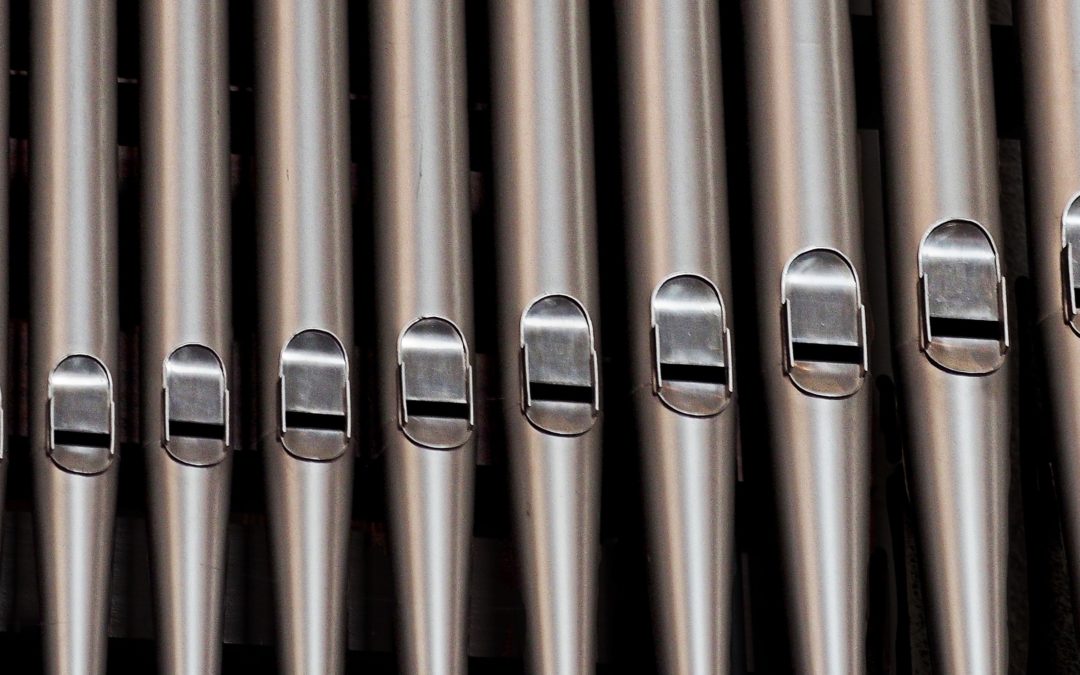
The Reluctant Organist by Janette Cooper (treasures from the back catalog)
So one of the best things about working at GIA is…the warehouse. Being this close to that much music, that many editions, stacks and racks and boxes and so much music all in one place. Seriously, I’m such a nerd that stepping into the building and smelling that inky publisher smell that lightly pervades everything, even the editorial department, makes me feel all warm and fuzzy.
But I can’t be the only nerd, right? I mean, look at this:
Tell me that doesn’t look like a really fun way to drop an hour or two, seriously?
There’s lots of great new stuff of course, but I’m having the most fun heading to the back of the warehouse and sort of pawing through the boxes of older stuff–books and resources and things that have sort of slipped off the radar in favor of newer products, but which actually have some great content and which, beneath their often dated-looking covers, have some very solid and currently-usable information inside them.
One of those products: The Reluctant Organist, by Janette Cooper, first edition published through the Royal School of Church Music in 1976, with a second edition in 1987. It’s a tiny little book, less than 40 pages long, but it is full of great information for “Reluctants” as the author calls them, describing her target audience on the opening page:
“…The organist disappears, the vicar looks round the congregation and sees Mrs. A whom he once heard play the piano at a children’s party. Told that the organ is very similar to a piano and that anyone can play a few hymns, she feels it would be ungracious to refuse to help next Sunday. She and the choir make valiant efforts and the following Sunday she has been prevailed on to repeat the performance. A year later she is still there…She is uneasily aware that the organ has more dissimilarities with her piano and he left her to believe…and Sundays come along so quickly–no sooner has she learnt the notes of the Whitsun hymns than Trinity is here. She tentatively asks the professional musician at the big parish church if he would give her a few lessons…He suggests that she join the local Organists’ Association, but on her first visit she finds the talk is all about wind pressure per inch, and the second is an organ crawl where everyone except her indulges in lengthy improvisation. She returns to her own church, and to her I offer this interim emergency recipe booklet.”
Perhaps I love this book so much because this was me when I started out on organ, having no idea what I was doing and no one to tell me what to do or how to do it. I so wish I’d had this book back then–her outline of the key points to the workings of the instrument is concise and clear, her approach to pedalwork for beginners is wonderfully commonsense, and I wish I’d known about it 20 years ago.
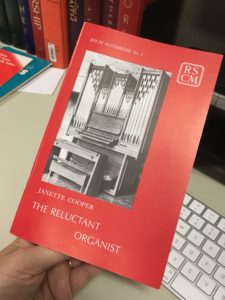 In this very short book she offers a crash course on the most basic of basics. Here’s just a sampling of her wit and wisdom:
In this very short book she offers a crash course on the most basic of basics. Here’s just a sampling of her wit and wisdom:
- What you’re looking at in front of you when you sit down at the organ for the first time (in the chapters “Geography 1” and “Geography 2”)
- Advice on how to start using the pedals: “I will outline an approach to pedalling which may bear more fruit than the stab-and-poke technique employed by many.”
- Permission to not start using the pedals: “If you are entirely rational and trouble-hating, be assured that you may be a very competent Reluctant with no use of the pedalboard whatsoever, and skip the next two chapters. It will save much agony.”
- Registration: “Your ears will tell you that an 8 and 2 can make a welcome change when used without the intermediate 4, that 16-foot manual stops can be unclear, and that the Swell Oboe can be particularly nasty when used with the Diapason. The matter of registration is subjective within reason: you must listen.”
- Rhythmic hymn playing: “…I do not mean merely putting notes down according to the metronome. Rhythm is closely linked to accent, and it may have escaped your notice so far that there is no mechanical way of making an accent on an organ…”
- The tremulant: “Now a few gadgets for Reluctants to use most sparingly. The tremulant gives a vibrato to the tone of some stops…and although it can be used to great effect in a few eighteenth and nineteenth century works, I urge you to forget its existence for the time being.”
- General professionalism: “Flinging oneself on the organ seat five minutes before a service only to find that chantbook and left shoe have disappeared, opening the hymn book with right hand while the left plays a repeated arpeggio over a firmly held pedal C–both are sure ways to mediocrity and/or disaster.”
Her writing “voice” is delightful and very British, at least to my ears, and I enjoy her writing while appreciating the common-sense approach she brings to what for many of us is a big intimidating instrument.
So…if there are any other “Reluctants” out of there–I’d highly recommend checking it out!
And if you’re ever in Chicago and would like to take a walk through the warehouse with me (I’m serious about that! Come visit us!), I’m always game.
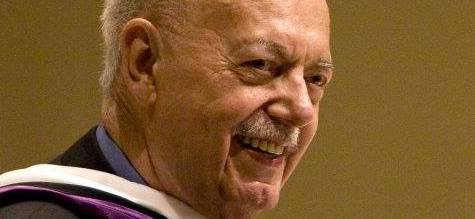
Richard Proulx: On Church Acoustics
This second post on acoustics and music-making in churches features an article by the late Richard Proulx in the first-ever GIA Quarterly magazine issue. It eloquently (if somewhat cantankerously*) lays out the basic problems and solutions. (Spoiler: carpet is never the solution.)
Click here to see the first post on acoustics in churches.
_____
Singing on Alien Ground
Richard Proulx
Wall-to-wall carpet. Padded pews. Acoustical tile. Acoustical plaster. Absorbent wall panels. Soft, rough-sawn wood. All designed to muffle, stifle, deaden sound.
There is growing concern among thoughtful liturgists and musicians regarding the crisis of unworkable acoustical environments being created in both new and renovated churches in this country. With evident purposefulness and at great expense, we continue to design and renovate worship spaces where members of the assembly hear themselves sing and pray only as isolated and detached individuals rather than as part of a unified community. Has the Church only been kidding when asking repeatedly for strong community participation? Have liturgists not been serious about a “ministry of the assembly”? When musicians’ cries for more careful acoustical consideration go unheeded, why are they then blamed for failing to produce strong congregational song?
Floors and “the bottom line.” Carpets divide people and destroy community in worship. The perception that wall-to-wall carpets provide “cozy warmth”—once considered a domestic luxury of having “arrived”—has a price in both liturgical involvement and long-term stewardship.
People tend to sing louder and better when they hear their voices clearly magnified, which is why some of us like to sing in the shower, underneath bridges, or in other resonant places. Rooms which “give back the sound” when people sing or read greatly enhance and encourage congregational participation.
One practical function of the floor surface is to conduct sound from one location of the building to another. While we often think of air as being the medium for sound, it is actually the floor, or air immediately above the floor, which amplifies the sound of voices and conducts it evenly throughout the entire worship space. (Electricity travels in the same way: over, not inside of, wire.) It is easy to see, therefore, how material used in floor treatment can either improve or reduce the efficiency of sound transmission. For community singing, this can be a critical factor.
Worship leaders, especially clergy and musicians, should occasionally test their acoustical perception by sitting in the midst of the assembly as members of the community itself. Sonic perspective gained only from sanctuary and choir loft are usually incomplete and imaginary. Experiencing the congregation’s vantage point can produce a fresh, even shocking, sense of reality about sound and sight, as well as many other things! Unfortunately, few clergy or musicians are willing to subject themselves to this practical, revealing exercise.
Unlike stone, wood, or other permanent materials, carpets always need to be replaced. Holes, tears, incense burns, salt from icy winter streets—all impact on the durability of even the most expensive floor fabrics.
At a time of heightened stewardship awareness throughout our parishes, initial investment in solid, permanent floor materials are better long-term bargains than materials which require periodic replacement. That is sound management and good stewardship.
Doctrine of electronic reinforcement. For church architects, floor treatment is an expensive design headache. Carpet is the expedient solution for cutting design and construction costs, even though architects know that replacement will be necessary, Ironically, both corporate and domestic architecture now favor hardwoods or ceramic tiles for floor treatment, and the crafts involved in producing them are enjoying a renaissance everywhere except in churches.
Once a worship space has had its natural acoustic muffled or amputated, attempts at “correction” via massive electronic reinforcement become essential for all “performers”: presider, lectors, cantor, choir, and instrumentalists. Rather than provide here subtle enhancement for clarity, sophisticated systems with computerized time-delay are required in dead spaced to bring the booming voice of The Electronic Church to the remotest corners of padded parish centers. This simulating of outdated recording studio techniques leaves out the most critical “performer” of all: the congregation, which must struggle with its role unamplified, unreinforced. Shall we also now provide each member of the community with body mike and earphones to electronically synthesize a corporate song? A poor, unworkable acoustic for worship demonstrates poor theology at the most practical level.
A challenging mandate. Since worship spaces have acoustical requirements and goals unlike those of other public buildings, it is critical that those responsible for redesigning and reviewing plans be diligent in compiling all available information necessary to make informed responsible decision.
_____
Originally published in GIA Quarterly magazine, issue 1:1. ©1990 by GIA Publications, Inc.
*This issue makes me cantankerous too.

Sing Amen! The Podcast, Episode 7: How to Love Wedding Music Ministry (Interview with Mary Prete)
Podcast: Play in new window
Complaining about weddings is probably the single favorite pastime of church musicians when they get together. (Okay, even as I read what I just typed, I have to acknowledge that many of my friends and colleagues have a much longer list of things and people we all love to complain about, but let’s just accept that this one is pretty high on the list. 😉 ) I’m honestly not a wedding-complainer, though–I have always really enjoyed sitting down with couples and helping them discover the musical possibilities for their wedding liturgies, and then being there with them to help them realize their vision for the day. And in my experience, they are generally really lovely, cool, smart people. Of course I have my war stories; we all do. But overall–it’s a pretty great thing to be part of. And I’m one of the least romantic people you will ever meet. (Just ask my husband.)
This podcast episode is edited down from a long conversation I had some months ago with my good friend Mary Prete, who was instrumental more than a quarter-century ago for developing one of the first and I suspect longest-running Wedding Fair programs around, at Old St. Patrick’s Church in Chicago’s West Loop. What struck me about her approach to wedding ministry was not just the way she applied her business-brain (she has a really good one) to the challenge of marketing and strategizing to get people to these fairs, but also the deep underlying sense of ministry and outreach with which she approaches the whole process of meeting and working with engaged couples to help them plan for their wedding liturgy.
Have a listen!
Music heard in today’s podcast:
Covenant Hymn (Gary Daigle and Rory Cooney) G-4017
As recorded on Praise the Maker’s Love CD-292
SingAmen! the Podcast, with Jennifer Kerr Budziak
Sound by Jim Bogdanich
SingAmen! opening music: Promenade, by Bob Moore (from Let Every Instrument Be Tuned for Praise, CD-491, from Liturgical Suite #4, G-4789.. ©GIA Publications, Inc).
SingAmen! closing music: Amen, (from More Sublime Chant, CD-459, The Cathedral Singers, Richard Proulx, conductor. ©GIA Publications, Inc.)
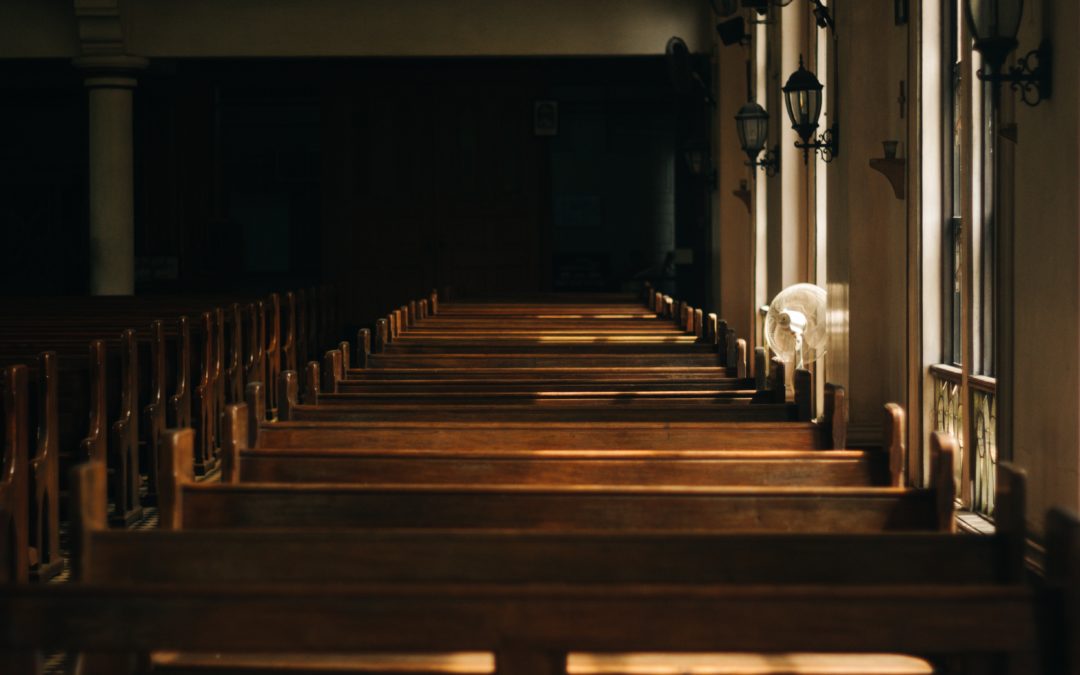
Acoustics in our worship spaces: Are planners talking to the musicians?
In the past couple of weeks I’ve talked with people facing a dilemma, and a real hindrance to their ability to perform their ministry well: the committees, architects, and pastoral staffs at their churches have built and installed whole new designs (or renovations) for worship spaces and/or sound systems–without ever once speaking with the musicians about the particular needs of their ministry.
This is a subject near to my heart, and it has been ever since my very first parish job, where I started just as the renovation of the church building began. I got there just in time to prevent them from irrevocably forcing the piano into a completely unusable spot, but I was too late, or too young, or too new, to save the choir loft. Apparently some nice parishioner who owned a carpeting business had donated carpet to the church, and one of the associate pastors had in the past gotten annoyed when the choir members shuffled pages and talked to one another during the liturgy (I told him, “I can put a stop to that, really.” He didn’t believe me.) and he deliberately wanted the sound tamped down up there. Plus, the carpet would be provided and installed free of charge. I said, “but it will absorb all the sound!” He said, “But we will have microphones!” I was 22. I lost. And it basically meant that, in this beautifully renovated space, the choir, singing from a lovely rear-of-church loft that should have sent the sound right down the nave and supported the people’s singing beautifully, was only audible through the speakers. Broke my heart. (Fortunately, a couple of decades later when the ancient held-together-with-chewing-gum-and-duct-tape* organ–which somehow was left out of the renovation, another really sad omission–was replaced, a nice hardwood floor was installed up there, so that space is now at last what it should have been ages ago.)
Even more important, though,** it is crucial that everyone involved realizes that we are not designing for a theater space, or a classroom, or a lounge, or a lobby…in all of these scenarios, the goal of the sound designer is to make sure the sound transfer is clear from the front, or the speaker, or the leader, or what-have-you, and damped down where the “audience” or “listeners” or “crowd” are located. But as we all know, there is no audience at liturgy. Even when we talk about “the choir” as being that group standing and singing together in the beautiful non-carpeted musician space, we are missing the point, because the assembly is the primary choir of the liturgy. If we are committed to fostering assembly song, we need to make it possible, even easy, for them to do so. Carpets, padded pews, sound absorbing wall tiles, low ceilings–all of these contribute to the individual assembly member being acoustically isolated from the people around them, and feeling as though they are the only person singing. When individuals don’t hear anyone singing around them, they are inevitably quick to fade out themselves, and the vicious cycle continues, and the assembly forgets its own voice.
In the coming months, I will be devoting some blog space a few articles I’ve located in the GIA archives on this subject, simply because I know a lot of people have questions and concerns. Most of the questions I hear boil down to this: “I know this is important, I know carpet is bad and over-miking is bad and reflective surfaces are good. Can you please give me some advice, resources, documents, and data, so I can take this information to the pastor/committee/builder?” (Click here for the second installment, Richard Proulx’s article “Singing on Alien Ground.”)
So, a few nuts and bolts:
- The first consideration in any acoustical situation needs to be the acoustic of the room you’re working with. Saying, “Well, the room has this problem, let’s fix it with the sound system” is usually going to be wasteful and self-defeating, because a flawed room won’t get the best out of your sound system either–remember, your sound system is working within whatever acoustic you give it; the electronic sound and the natural acoustic sound will have to work together. Fix the room first. The better the acoustics in the room you create or alter, the less work (and money!) will be required of your sound system.
- Perhaps your room is too live, and needs a little absorption of the sound. Carpet is not the answer. The hard reflective surfaces should be right around the space where the sound is generated (i.e. where people are speaking/singing). If any absorption needs to happen, it should happen far away from your singing assembly, preferably as many feet above their heads, as is possible.
- Shape and size of the room matter a lot. Long narrow rooms with high ceilings make it easy for sound to travel along the long axis; fan-shaped rooms are much trickier and introduce new challenges–but they are challenges worth taking the time and effort to address. (You can’t just “fix” these challenges with a sound system; see #1.)
- Ceiling height is almost as important as the overall shape of the room. For sound to travel well, you need significant space over people’s heads.
- Perhaps most important: your sound consultant must be someone who understands the unique needs of a room that supports assembly song. Studio-type sound-equipment engineers have been known to come into a room and say, in essence, “okay, let’s dampen and absorb ALL of the natural acoustic of the room, and then we have complete control and can replace it with a well-placed sound system.” If your engineer says anything even faintly like this…run away, because it means they do not understand the needs of your space or your liturgy.
- This last one is neither a nut nor a bolt, nor anything I researched; it is a Jennifer musing, but I think it might still be helpful. We know that (excepting of course the electronic consistency of digital keyboards and such) every piano is unique and a little different from every other; every organ has its own personality and character; every guitar has its own sound and tone color. They are not animate objects, but each is unique and possesses its own voice and resonance, and they are the instruments with which we make music. The room in which we make music is also part of the music-making. The room is the resonating chamber for the voice of the people of God as they sing. To be cold and clinical about 4 walls and a ceiling is to miss the point. The room makes music with you. Make it your ally, your partner, your friend, and the music will show it.
Here also are a few notes from the liturgical documents, in case anyone needs solid documentation to bring to a committee: Sing to the Lord has a solid section about acoustics in churches, starting in paragraph 101. It doesn’t address sound systems per se; it seems to take the opinion that in a well-designed acoustically sound room there will not be much need for amplification, but that if there is, it should not overpower:
101. Acoustics refers to the quality of a space for sustaining sound, especially its generation, transmission, and reception. While individual ministers of the Liturgy, ensembles, and even choirs can be sound-enhanced through amplification methods, the only amplification of the singing assembly comes from the room itself. Given the primacy of the assembly’s song among all musical elements of the Liturgy, the acoustical properties of the worship space are critical. For this reason, specialists in acoustics should be consulted when building or modifying liturgical space.
102. If each member of the assembly senses his or her voice joined to the entire community in a swell of collective sound, the acoustics are well suited to the purpose of a gathered community engaged in sung prayer. If, on the other hand, each person hears primarily only his or her own voice, the acoustics of the space are fundamentally deficient.
103. Sound-absorbing building materials include carpet, porous ceiling tiles, soft wood, untreated soft stone, cast concrete or cinder block, and padded seating. Avoiding excessive use of such materials makes it easier to achieve the ideal of many voices united in song.
104. The acoustics of a church or chapel should be resonant so that there is no need for excessive amplification of musical sound in order to fill the space and support the assembly’s song. When the acoustics of the building naturally support sound, acoustic instruments and choirs generally need no amplification. An acoustically dead space precipitates a high cost of sound reinforcement, even for the organ. (Sing to the Lord #101-105, ©2007 USCCB)
Built of Living Stones, the USCCB document on environment and art in worship, has a section on sound in church design entitled “Sound in the place of Worship.”
Silence is the ground of all prayer. From contemplative silence emerge the sung and spoken prayer of the entire assembly and the prayers and proclamations of the various ministers. Liturgical celebrations call for the clear transmission of the sung and spoken responses of the liturgical assembly, as well as of the words of the individual ministers such as the priest celebrant, the deacon, the readers, and the cantor and leader of song. In addition, the space should provide an environment for instrumental music that supports the assembly’s song and worship.
The first consideration in providing quality sound transmission is the acoustic design of the building. The interior surfaces such as the walls, the floor, and the ceiling affect the transmission of sound, as do design features like the ceiling height, the shape and construction of rooms, and the mechanical systems such as heating and cooling units and lighting fixtures. The sound-deadening tiles so vital to noise reduction in gymnasiums and other public buildings will be used rarely in a church and only with professional advice to reduce or eliminate outside noise. Soft surfaces such as carpets, rugs, and large fabric wall hangings absorb sound, while hard surfaces such as stone, tile, glass, and metals reflect it. A combination of sound-absorbing and sound-reflecting surfaces properly applied and used in correct proportion provides the kind of system needed for a worship space.
Acoustical engineers can help parishes design a building capable of the natural transmission of sound; they also can be of great assistance in the renovation of existing buildings.
Another aspect of an effective audio environment is the electronic amplification system, which can augment the natural acoustics and can help to remedy problems that cannot be solved in other ways. Planners also should consider provisions for sound in the nave, in the sanctuary, and in adjacent spaces such as the gathering area and the space around the baptismal font. Accommodations should be made for people with special hearing needs.
Providing for the amplification of the proclaimed and sung word and for instrumental and choral music is a complex task that demands the skills and experience of experts in the field of acoustical design. Choosing local vendors who do not possess the requisite skills to understand the complex needs of the liturgical assembly may prove to be a serious, even costly liability. (#221-225, ©2000 USCCB)
One final, happy story.
My current place of part-time work and worship has just been blessed to open a new space. We are a large community that on many Sundays just can’t fit everyone into the church, so for years we have been holding “overflow” liturgies in the church basement, where there wasn’t even enough space for the additional people; we have now just moved into a new building, one with a large community space designed and created to be flexible and usable for many kinds of events, but with regular worship as a key piece.
Way back when this all started, all the department heads were invited to a meeting in which the decisions that had been made would be presented so we would all know what was happening. One of those decisions was that the new floor would be carpeted.
I had fore-warning of this, so I went in armed and ready. I had articles, I had figures, I had arguments and counter-arguments, and most of all I had an understanding of the issues. I calmly and articulately was able to shift the conversation from “how will we keep the carpet clean” to “perhaps another flooring type would work better.” I was able to talk about the big points I noted above, I was able to talk about the need for the reflective surfaces around the singing people, and when they showed me their calculations for exactly how much absorption the room would need (it’s basically a giant math problem; it was really kind of cool!), I was able to steer them to placing those absorptive materials up at higher spaces in the big room, so the sound would not get out of hand but the space where people sing would be appropriately reflective.
At the end of the meeting, the architect looked at me slightly aghast, and said, “Why haven’t we been talking with you all along about this? We had no idea. This changes everything.”
The space is beautiful. There is no carpet. This Sunday I will get to find out how it works with a real live assembly…I can’t wait.
–Jennifer
*I’m kidding about the chewing gum, but not the duct tape…the blower was literally held together with duct tape.
**To be clear: not putting carpet in your choir lofts is pretty darned important! Do. Not. Carpet. The. Music. Area.

Sing Amen! The Podcast, Episode 6: A Contemporary Sampler
Podcast: Play in new window
Greetings all! Here is the contemporary sampler recording I said I would do, since I’ve been leaning more heavily in the choral direction for a while. And it is definitely a sampler; there is no real guiding principle for what is chosen here beyond it being songs I like, in an order that seems to hang together well, by a solid cross-section of composers. (And even with no repeats, there are of course quite a few composers–some of whose omission from this first contemporary music episode have had me waking at two in the morning with anxiety-laden thoughts, and who I hope are still my friends–I have not yet included on this podcast, but I’ll get to them as we go!) The idea here is half an hour or so (okay, closer to 40 minutes) of nice music you can just listen to and enjoy. We’ll get more focused later on as we go. It is still only early September, after all. 🙂
I mention this on the podcast as well, but please do bear in mind that while you will be hearing in this podcast the studio-recorded versions of these songs, this is all music created for use in liturgy (I’ve used most of them myself at one time or another), and they are singable and lovely, so I hope those of you who are responsible for putting songs on the lips of your assemblies give some of them a try.
I don’t have a whole lot I need to say about this–just listen and enjoy! See below for a list of where to find these songs if you’re interested. And have a great week!
–Jennifer
Music heard in today’s podcast:
One in your name (Ian Callanan) G-6956
As recorded on In Beauty We Walk CD-881
Note: This is a pod-only edit of the song, and it is not the one from the CD or the octavo, which contain the prayer for the blessing of water; this one is just for listening purposes and goes straight into the singing for the Rite of Sprinkling. The octavo has the full version.
The Lord is my Shepherd (Gary Daigle) G-8283
As recorded on To You Who Bow CD 998
My Only Desire (David Haas) G-9471
As recorded on I Will Bring You Home CD-1041
Recording artists: Hangad
Turn Around and Believe (Rory Cooney) G-8755
As recorded on To You Who Bow CD 998
Will the Circle be Unbroken (Tony Alonso) G-6914
As recorded on Songs from Another Room CD-648
Who is the Alien? (Lori True) G-6711
As recorded on There is Room for us All CD-639
New Heaven and Earth (Jeanne Cotter) G-9345
As recorded on Tender Hearted CD-969
Go out to the world (Chris de Silva) G-6930
As recorded on One Love, One Song CD-713
SingAmen! the Podcast, with Jennifer Kerr Budziak
Sound by Jim Bogdanich
SingAmen! opening music: Promenade, by Bob Moore (from Let Every Instrument Be Tuned for Praise, CD-491, from Liturgical Suite #4, G-4789.. ©GIA Publications, Inc).
SingAmen! closing music: Amen, (from More Sublime Chant, CD-459, The Cathedral Singers, Richard Proulx, conductor. ©GIA Publications, Inc.)
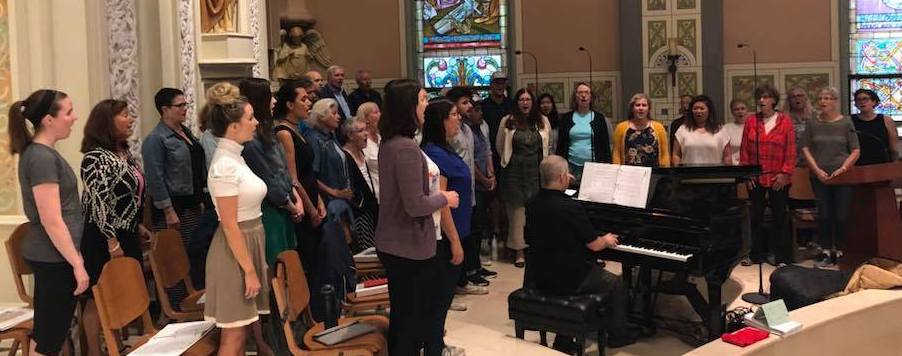
“Well begun is half done,” or, how do you start your choir season?
(I had somehow always thought that the quote above, “Well begun is half done,” was from Mary Poppins or something like that, but when I looked it up for this post, it turns out it’s Aristotle. Go figure. As much as I try to read, my ignorance remains legion…but it’s still a great quote expressing an important reality.)
For those of us who take the summer off, we are probably gearing up right about now for our first choir rehearsals of the season–if it hasn’t already happened. Even many churches who continue to have their choirs sing through the year will often take the summer off of rehearsals, singing easier or more familiar music through the season, and may be on the verge of getting started again with weekly practices.
So I’m curious–how do y’all* approach this first rehearsal? What do you try to accomplish? Do you rehearse for a few weeks before the choir starts singing on Sunday? Do you even take the summers off at all? Do you, like me, spend weeks stressing and planning and figuring out how those first few meetings with your choir will go, knowing that they will set the tone for the next 9 or so months?
For what it’s worth, here’s how I’ve always done it:
I begin rehearsing the choir at least two (sometimes 3) practices before the first time they are in front of the congregation. This is really important, and I recommend it to everyone. Choir rehearsals aren’t just about each person learning their own music–they are also about the ensemble, finding a collective sound, getting used to each other, and becoming a unit; that can’t be done in one 90 minute gathering that also includes trying to get the music set for Sunday. So the first rehearsal or two are usually heavy on the warm-ups and vocal exercises, with a lot of canon singing and tuning and collectively remembering what it’s like to sing together. Since I’m also someone who likes to plan out the whole musical and choral year before we start the season, I also like to spend some time in this first rehearsal introducing them to some of the new octavos that we will be learning through the year–sort of a “coming attractions” kind of thing. (Especially that challenging anthem for Christmas Eve.) Then we also get started on the first month or so of planned music for the season–not just the first Sunday they will sing, but at least 3-4 weeks beyond that.
Here’s the thing: It doesn’t matter how accomplished your choir is, and that they can adequately learn their music for the coming Sunday in just one rehearsal. But I can guarantee that, whatever level they sing at, from the smallest beginner group to the most elevated professional cathedral choir–however good they are in one rehearsal, they will be better if they have two. Even if the total time spent is exactly equal–you can spend 30 or 45 minutes on a piece in one go, but that won’t be as valuable as 20 one week and 25 the next. It takes the human brain time to process stuff, and if we don’t give it that time, it won’t perform at optimal levels. Once the season is going, for every 90-minute rehearsal I hold will spend maybe a third of the time on this Sunday, at most, and the rest on the music for the Sundays that follow. If it’s the Thursday before an anthem is supposed to be programmed, or a new song for the assembly introduced, and the choir doesn’t know it yet–that’s a problem. But it’s a problem I can always see coming, because we practiced it last week, and the week before, and as many weeks before that as were necessary. So, this approach can work really well, but it is only possible with good planning, and a real view and vision of where you’re going with the group.
And of course, after the first rehearsal, we have social time–whether at the local pub after rehearsal or (better!) snacks and drinks brought in by members of the choir, or (best!) both.
So, how do y’all do it? Any other tricks or pearls of wisdom to share?
–Jennifer
p.s. For a lot of stuff about nuts and bolts rehearsal pacing and planning, I’d recommend checking out Michael Kemp’s Igniting Choral Rehearsals with Efficiency, Artistry, and Motivation. It’s a really good book, full of tools for the toolbox…
*I live in Chicago now, but I grew up in Maryland, which is technically south of the Mason-Dixon line, and “y’all” has been a part of my vocabulary forever. People here in the North occasionally deride me for it, but I’m not apt to change at this point, and y’all may just have to deal with it. 😉

Sing Amen! The Podcast, Episode 5: In Time of Lament
Podcast: Play in new window
We had a different podcast all set for release today, but with the news out of Pennsylvania last week it doesn’t feel like what we need is information or input — we need time to lament and grieve and process, to deal with our sorrow, our anger, and sense of betrayal, our feelings of helplessness…words don’t get us very far in times like these, but being who we are, when words don’t cut it, we turn to music.
So today’s podcast is intended to be sort of a journey in music, hopefully a quiet time to just be still and let ourselves be ministered to a little. I won’t talk much on this one–in times like these, it’s better to remember that God can do whatever speaking each of us needs to hear in our hearts.
Peace be with you.
Music on today’s podcast:
Lament for the Innocent (Solas)
As recorded on Winter Solas CD-511
By the Waters of Babylon (Jewish canon arr. David Buley) G-5941
God Weeps (David Haas/Shirley Erinna Murray) G-6694
As recorded on God is Here CD-631
Kyrie (Marty Haugen) G-5651
As recorded on Gift of God CD-501
Lead me on (Brian Schmidt) G-7457
As recorded on Silence into Light CD-1026
Far Beyond (Liam Lawton) G-6803
As recorded on Sacred Land CD-662
Quietly, Peacefully (Lori True) G-6718
As recorded on There is Room for us All CD-639
Thuma Mina (South African)
As recorded on Honey from the Rock CD-1002
Love, Burn Bright (Chris de Silva) G-8714
As recorded on Love, Burn Bright CD-1014
How Can I Keep from Singing (Robert Lowry, arr. Gerald Custer) G-7227
As recorded on Inscape: Choral Music of Gerald Custer CD-754
I Will Lift up My Eyes (Tony Alonso) G-8675
As recorded on Pilgrim CD-929
SingAmen! the Podcast, with Jennifer Kerr Budziak
SingAmen! opening music: Promenade, by Bob Moore (from Let Every Instrument Be Tuned for Praise, CD-491, from Liturgical Suite #4, G-4789.. ©GIA Publications, Inc).
SingAmen! closing music: Amen, (from More Sublime Chant, CD-459, The Cathedral Singers, Richard Proulx, conductor. ©GIA Publications, Inc.)
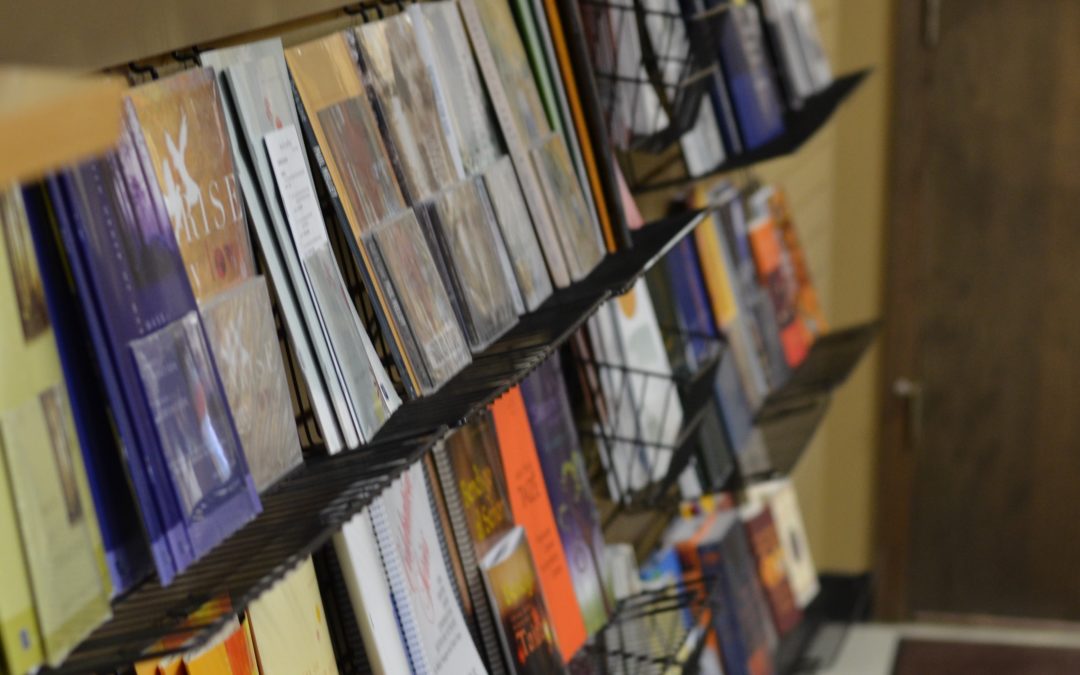
How to introduce new assembly music?
(Another entry during this month when a lot of us are looking at the Year of Grace to come, and thinking about what we will be putting in front of our assemblies to sing…as always, I’d love to hear from folks in the comments, let me know how you approach this process!)
It’s a dilemma, pretty much all the time–how much new music should we be introducing to our assemblies? How often, how difficult, how much? Which songs will take, and which will fall flat? How many times does the assembly need to sing them before they can “own” them? Is there a way to introduce them that balances increasing familiarity with freshness and life?
To be clear–I’m not going to even attempt to answer those questions here, because the answers will vary immeasurably from parish to parish and sometimes even from liturgy time to liturgy time within the same parish. I keep being reminded again and again of our old friend the “pastoral judgment” from Sing to the Lord and its predecessor Music in Catholic Worship–the one that “takes into consideration the actual community gathered to celebrate in a particular place at a particular time” (STTL #130) and asks if a piece of music is “capable of expressing the faith that God has planted in their hearts and summoned them to celebrate”–not just in general, but here, now, today. We know that the three judgments (liturgical, pastoral, and musical) must always work in concert with one another as a single evaluation, but the “pastoral judgment” can be a slippery little thing–for any given piece of music, you can put it through the liturgical and musical piece of this evaluation one time, and you’re done–but the outcome of the pastoral judgment changes week to week, year to year, parish to parish, and is maddeningly hard to pin down. It needs to be visited and revisited with all of our music, over and over…
But even with that caveat, there are some guidelines we can follow around how to approach the question of introducing new music for the assembly.
- First: even if the answers to these questions (how often, how difficult, how many times, which songs, etc.) are going to change and shift with the wind, it is crucial that we do ask them. And answer them. Over and over again. If we are committed to empowering our assemblies to find their voice, we must have a conscious awareness of how to best serve them, and there is always a better plan than just winging it–I’d be lying if I said I’ve never fallen into the “This is a nice new song I’d like to introduce to my assembly, and it’s perfect for this Sunday!” trap, and sometimes it’s worked okay in the long run, but most of the time I’ve regretted it. Know your people.
- Keep a vibrant and anticipation-filled “hope chest” somewhere in your arsenal–whether an online file or a simple manila folder in your desk–where all the pieces of music you know would be wonderful for your assembly (or choir–I have a separate folder for choral pieces) when the right moment comes can be stored safely and without risk of being forgotten. Jot notes on the covers–if you find a great Year A Communion song, but you’re in Year B, put it in there with a note to come back to it in 1.5 years. If you have one too many bright and joyful Easter verse-refrain songs (rare, in my experience–I feel like I’m constantly looking for more of those), but find a new one you’d like to introduce when the time is right, drop it in there too, and mark it so you’ll remember to return to it when you plan Easter next year. Two weeks before Lent should not be the time to decide to page through the hymnal for a new Lenten opening rite; keep yourself ready with good choices before you need them, and the choices will be that much easier.
- Take the long view! Just as homilists are taught that they do not need to say everything they can think of about the readings for Sunday this one year (at least, we hope they are taught this), we as musicians do not need to do every possible suitable piece of music this one Sunday, or this year, or even in this couple of years. In an earlier post I talked about doing our liturgical planning a year at a time; this is a great way to plan for the future–not just the next liturgical season, but the full year. Commit to finding each new piece of music its absolutely right placement and moment for the life of your parish; both song and singers will be better served that way.
- Decide before slotting a song into your seasonal or annual schedule how many times and at what proximity you want to introduce it to your assembly. My own game plan has always looked something like this: Sing the new piece 3 weeks in a row; take two weeks off; sing it two weeks in a row; take three weeks off; then sing it one more time. Then leave it alone for maybe 3-4 months but try to find a time to bring it back at least once or twice after that. As you can see, this is a serious commitment. Do the math; for every new song I teach to an assembly, I’m committing to an 11 week or so sequence of Sundays to get it fully and solidly into the parish repertoire. (In the interest of full disclosure: many seasoned and successful liturgical musicians think I am crazy and probably a little, shall we say, overzealous in my methodology here. I’m not saying they’re wrong. But it works. I don’t think any of those critics have ever actually tried it.) Obviously some flexibility is needed here, because sometimes it just won’t work. And a new piece for a particular liturgical season needs to be adjusted to fit the Sundays the season addresses. But one way or another, find room for it in your seasonal lineup before you commit to it. It’s better to not introduce it at all than to introduce it haphazardly and have what could have been an important part of your repertoire meet an unsuccessful introduction. First impressions, you know?
- Teach it to your assembly before singing it in the liturgy. This is one of those “your mileage may vary” suggestions; some parishes have great success with this process, because in addition to helping familiarize the people with the new music it also helps gather people’s attention and focus before the start of the liturgy. However, in places where the sacred silence in the room for an extended time before mass is an integral part of parish life, having someone stand up and break that silence can feel awkward and off-putting. There are different approaches to take for this, but “lining out” (singing a line and inviting them to echo it back to you) seems to be one of the best. (Diana Kodner Gokce’s Handbook for Cantors has a good section on this, starting on p. 25.)
- If actively teaching a piece to the assembly before Mass is not something that works in your place, consider the “stealth” approach–one week, have the new melody be played as an instrumental prelude; another week or two, have the choir sing the piece as a choral anthem. Then invite the assembly to join in on the refrains only. (But be subtle in how you say this when announcing it–“Please join in singing the refrains of ‘Bread of Life from Heaven'” works well; avoid any language that directly dis-courages them from singing.) Within a few weeks, they will have heard it enough that it becomes easy to join in.
- Avoid placing the new song at the end of Mass. Whatever we sing last should be solid and comfortable and familiar and with a feeling of success. Don’t risk sending people out in a state of vocal defeat or uncertainty. Even if the song or hymn might work better as a closing than an opening or Offertory, keep it out of the closing spot for the first few times. The opening is also a chancy place for a new song if you have not been able to directly teach it to people; see what works best for you and your community where this is concerned. But again, whatever we sing first will set the participative tone for the rest of the liturgy, so be careful there as well.
- Trust your judgment, but stay on top of your own biases. We all have them. There is the music we like, and the music we don’t care for–but if you find that you yourself love every piece of music you put in front of your assembly, you’re probably short-changing them. Music is a subjective thing, as is taste, and the variety out there is huge. That’s not to say that if a piece of music fails the liturgical and musical judgments above you should program it just because people enjoy it, but keep your ears wide open, especially during those pieces that don’t do much for you aesthetically, and see what’s happening in the pews. It’s pretty humbling.
So…that’s what I’ve got! I’d love to hear any more suggestions or ways you go about making choices or introducing them to your people. Peace to all!
–Jennifer
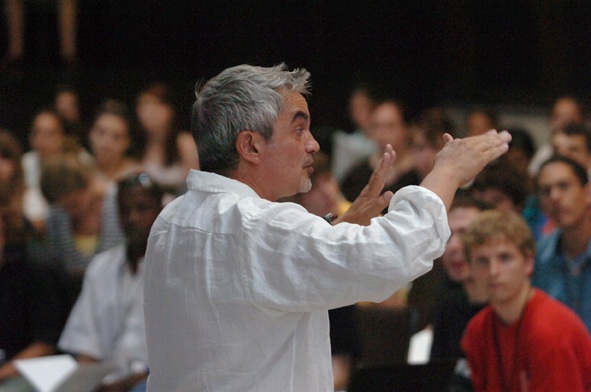
Sing Amen! The Podcast, Episode 4: Dr. James Jordan, On Trust, Honesty, and Breathing in Front of Other People
Podcast: Play in new window
As promised, this episode of our podcast features a conversation with conductor, teacher, and author Dr. James Jordan–He is basically one of the giants in choral music and education right now, a professor at Westminster Choir College and conductor of the critically acclaimed Westminster Williamson Voices, the editor of GIA’s Evoking Sound choral music series, which we heard a small sampling of in our last podcast episode (so go back and check that out if you missed it!), author of a continually expanding collection of books and resources about music-making and conducting, and just a generally amazing human being. (Check out his author page at GIA to get a look at all the things he’s up to.) He is also conductor of The Same Stream, a fairly new choir of former Westminster singers whose first full length recording has just released, and it’s absolutely gorgeous. I first encountered his work through The Musician’s Soul, a lovely small volume that feels like a musician’s retreat in print form, and it completely changed the way I think about myself as a musician, a conductor, and a human being. (And the books just keep coming–The Musician’s Spirit, The Musician’s Walk, Evoking Sound, The Musician’s Breath, The Conductor as Prism, and now The Moral Acoustic of Sound…and those are just the ones I can see from my desk as I’m typing this; there are plenty more!)
Dr. Jordan obviously approaches his art, and the whole premise that honesty and authenticity and love and trust are crucial components to music making, from the perspective of a choral conductor, which is of course his world. But these ideas go way beyond choral singing and music direction, and I hope musicians of all stripes will find something to take away—because a lot of what Dr. Jordan talks about here in the context of choral singing applies to the work we do in our churches not just with our music ministers but also with our assemblies, to help them find their voices and their place in the shared music-making.
If you find any of this intriguing, you won’t want to miss Dr. Jordan’s conducting workshops at the GIA Fall Institute this October 11-13 at Fourth Presbyterian Church in Chicago–please see the link to the right for more information. (Seriously, so much great stuff at this institute, I hope to see you there!)
Enjoy!
–Jennifer
Music heard in today’s podcast:
As I Walk the Silent Earth, G-8613
Text and music by Thomas LaVoy
Series: Evoking Sound
Recorded on: Hole in the Sky, by the Westminster Williamson Voices, James Jordan conducting
Note: please do follow the link above and see the composer’s notes on this gorgeous work, which he composed in tribute to this stunning chorus that he had sung with during his time at Westminster.
SingAmen! the Podcast, with Jennifer Kerr Budziak
Sound by Jim Bogdanich
SingAmen! opening music: Promenade, by Bob Moore (from Let Every Instrument Be Tuned for Praise, CD-491, from Liturgical Suite #4, G-4789.. ©GIA Publications, Inc).
SingAmen! closing music: Amen, (from More Sublime Chant, CD-459, The Cathedral Singers, Richard Proulx, conductor. ©GIA Publications, Inc.)
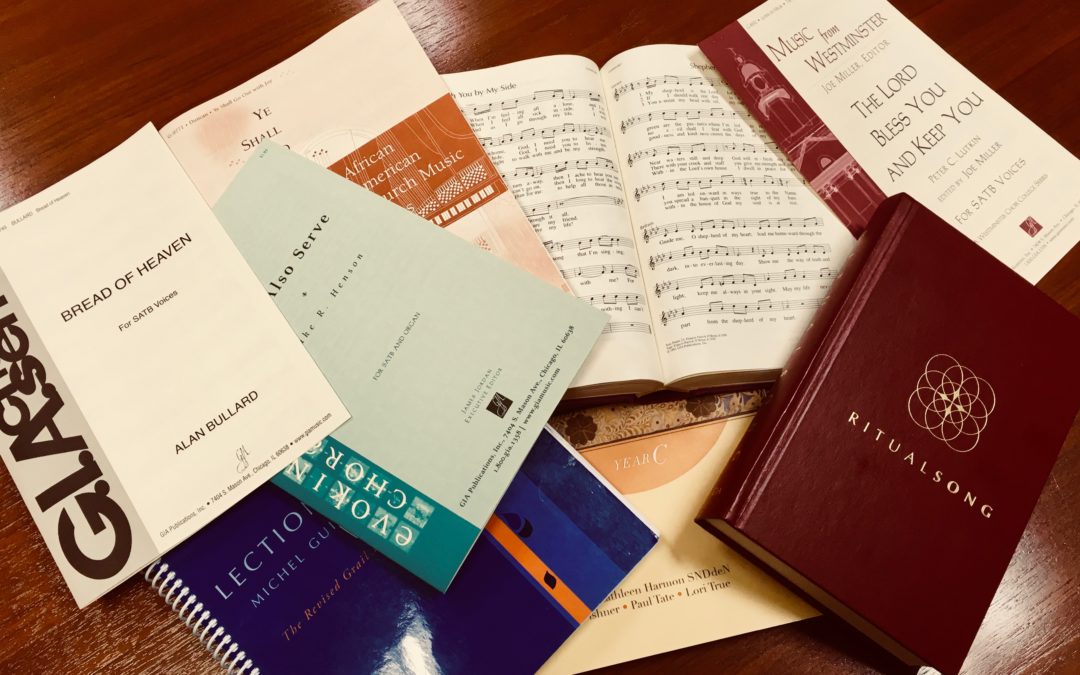
Getting ahead on music planning
Here’s a topic that comes up periodically on various forums: How do you deal with music planning for the liturgical year?
Last summer, in the GIA Quarterly (29.2), Christian Cosas wrote a great article about his process for music planning at his parish, called “Planning Music for Liturgy: Seeing the Forest for the Trees.” He walked the reader through his process for looking at his parish repertoire and planning a season at a time, and he was even kind enough to share his online spreadsheets. (They can still be viewed at giamusic.com/cosasdownloads.)
My own process for music planning seems kind of radical to some: I prefer to plan the entire liturgical year before the year even starts–and I do it usually within one week’s worth of time. This is one of those tasks that honestly feels big at the start, but wow does it feel good in late November or early January when you suddenly realize there is a lot to do and not enough time to do it in…July and August are a great time to take the long view, get ahead, and give yourself one less thing to worry about in the thick of the year. With the happy side effect of having a beautifully unified parish repertoire to move forward with.
Everyone can of course figure out their own way to do this, but this is how I work: Usually at some point late in the summer, I block out maybe 3 consecutive days at my office during which I have no scheduled appointments or meetings. I have settled into a fairly stable process for this:
Before Day One (usually in early July): I prepare a complete repertoire summary of the previous whole season–what we sang, how many times we sang it, how it went, where there is or is not crossover between different liturgy times (did choir Masses with choral anthems here and there mean certain rep pieces didn’t get used as often there?), which songs were new, which songs are old favorites, which songs (old or new) should probably be retired from the repertoire, and so on. I’ll do a fuller blog post on this process, but it is tremendously important for knowing where you’re coming from, before you move forward. (NB: If you use a spreadsheet that can do this categorizing for you, that’s great–but before planning a new year, it’s important not just to have the data, but to explore the data–know what it says, be familiar with it, have it on the tip of your brain in a big-picture kind of way.)
Day One:
- First, I read through the Lectionary readings for the entire liturgical year. (The logical place to start would probably be Advent, I suppose, but since the rhythm of my parish life has always been school-year-driven, it has made more sense to just pick a good “starting” Sunday sometime in late August or early September.) I go beginning to end, in one sitting, and I do not take notes; I just read.
- Second, after finishing the first time through and taking a brief break, I go back to the beginning and read it all again. It’s important to do this fairly soon after the first read, while the imagery and ideas are all still in the brain; this time, going back to the beginning of the upcoming season, I have in my head a fresh awareness of what is to come in the Lectionary cycle. This time, I do often take notes–nothing big or important, just anything that pops into my head: obvious songs that link well to the full year, images I notice in Advent’s readings that I remember from the previous read-through resonate in an interesting way with something in early summer of the coming year, anything unexpected…
- After the second read-through, I prepare my planning document for the whole year. This part is a little more boring, and while it’s easier if you have a spreadsheet system worked out, it’s always going to be a little tedious–but do it anyway. Every Sunday, every date, every season and/or name of the feast/Solemnity, for the full year. If you are in a place where different choirs minister at different liturgies or not every single week, indicate that as well. (Yes, you need to know by early August exactly which dates your Children’s Choir is singing–another topic for another day, but consistency is huge with volunteers and especially kids and their parents!) Add the holy days and sacramental celebrations and every single thing you know is going to happen this year. Leave a space or field for “liturgy notes.” Every bit of data you have about the flow of the liturgical year, both in the wider Church and within the rhythm of your own parish. (The added benefit of doing it now is that your brain will be churning away under the tedium of the process, thinking about everything you read and almost unconsciously applying what it remembers to the creation of this document. At least mine does.)
Day Two (the next day): Now you’re going into the actual musical selection phase of the process. Hopefully the overall thrust of the readings and the layout of the liturgical year are still more or less fresh in your mind.
- Go through the readings in the Lectionary Cycle a third time; this time, for each Sunday or celebration of the church year, jot down a brief summary of the readings in your “liturgy notes” space; what are the primary images, how do the readings tie together, and what over-arching ideas come to mind? Sometimes the three spoken readings will tie together in an easily unified statement, but more often this will look like 3 individual sentences (one for each of the spoken readings). The important thing is to be able to glance at this field and have a basic sense of what will be going on in the readings and, by extension, the homily for that Sunday.
- Go through the year and mark the proper Psalm, both by number and with its prescribed response, into your planning document. (If you end up using a seasonal psalm or something other than the prescribed psalm, you’ll at least have the imagery and ideas behind the proper represented in your document.
- (or 2b, actually!) It wouldn’t hurt to do the same thing with the Entrance and Communion antiphons for the year, if you want to be really connected to the Missal and the liturgical cycle–this gives you another lens for focusing your music choices. It’s also a big piece to bite off, so honestly if you’ve never done the full-year planning before you might save this for your second or third year walking through the process…the good news is that if you have a flexible planning document it’s easy to navigate these, since they do not work on the 3-year cycle the readings do–do them once, and you’re pretty well set for future years.
- Go through the year and add to your planning document all the service music you plan to use throughout the year, by season. For some people this is a steady rotation that does not change much or at all from year to year; for others you might need to make some decisions when you get to this point. Important: if you are introducing any new service music, make sure to indicate it in bold type or some different color so you have an immediate visual connection to which Sundays or seasons already have a significant “unfamiliarity quotient” that you’ll be putting in front of your assembly.
- Go back through your stack of music from the NPM conference and/or summer reading sessions you’ve attended, as well as your “hope chest” if you have one (that’s for me a folder or box of pieces I’ve come across in years past that didn’t quite make it into the rotation–but I hold onto them, because some year it’s going to be the right year!), and choose the new music you’d like to have your assembly learn this coming year. There’s no magic number for this–I’ve worked in parishes with assemblies that could easily assimilate a dozen or more new songs in a year, and others where the limit was maybe 5-6…but it’s something you should keep in mind as you plan. With the readings of the year in mind, select your new music and make sure you have good spots in your calendar to teach them to your assembly and give them time to settle in. (I’ll have another blog post on slating new music into your calendar soon.)
- Now, once all these other pieces are in place, go through the liturgical cycle once again, with your last year’s annual summary on one side of you and your Lectionary on the other, and select music for the full year; fill in your blanks, balancing new music with familiar gems, knowing before you start the year that even if you need to make changes later or discover some new great piece, you at least have a solid plan for the year.
Good luck! Seriously, starting to do this changed my life as a church musician, and the gift of not going nuts mid-year and losing track of things was incredibly valuable. Give it a try!
–Jennifer
Why Do We Sing?
By: Diana Kodner Gokce
Explore Sing Amen
Looking for more great resources, articles, podcast, and more throughout all Sing Amen blogs? Search through the site here.
Search By Category
Search Archives


